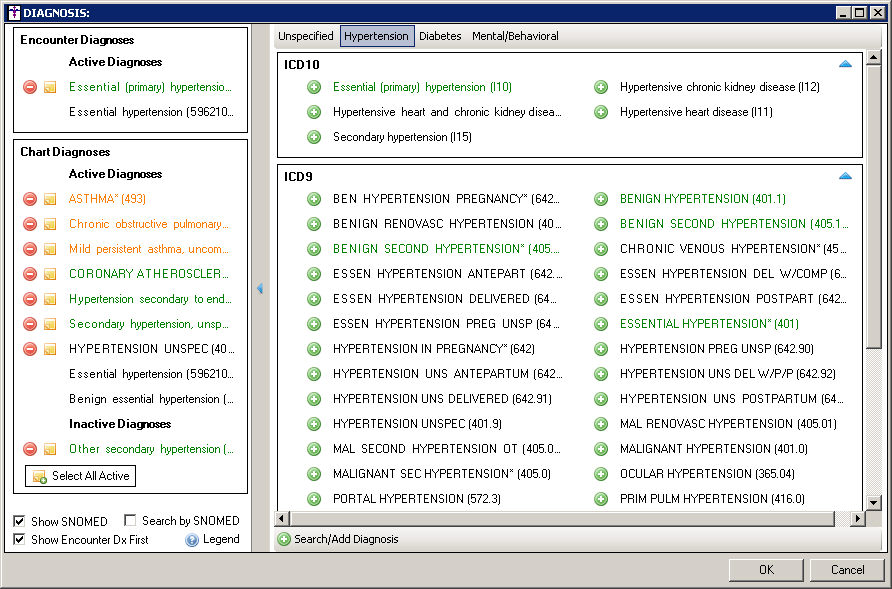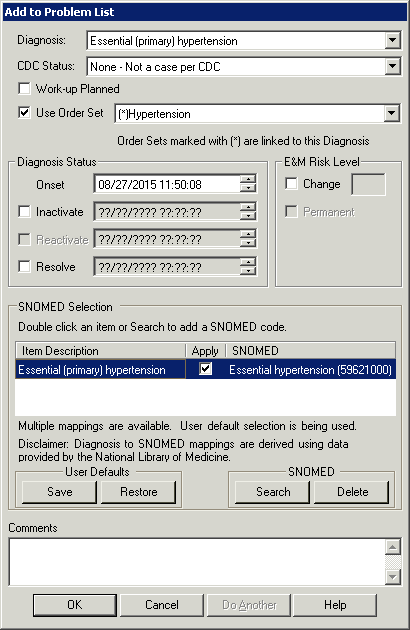Open
a patient's chart note.
Click
the Open Diagnosis Checklist  button in the checklist bar to access the Diagnosis checklist.
button in the checklist bar to access the Diagnosis checklist.
NOTE: You also have the ability to Add
a Diagnosis that is not in the Diagnosis Checklist
via the checklist bar by clicking the Search/Add
Diagnosis  button.
button.

When
the diagnosis checklist dialog is opened, you will see two panes: the
right being the template that was set up in template editor, and the left
representing the Facesheet to show existing Chart Diagnoses, as well as
any Encounter Diagnoses which have been previously selected in the current
note.
The diagnoses appearing in the left pane (Encounter Diagnoses and Chart
Diagnoses) are color coded to easily identify those codes missing an ICD
code (red), those diagnoses that do not have a SNOMED code attached (orange),
and those diagnoses that are part of an order set (green). You can click
the Legend button to view the
color scheme.
In the bottom of the left pane there are the
following options: Show SNOMED, Search by SNOMED, and Show Encounter Dx
First. When the Show SNOMED option
is checked any SNOMED codes attached to a selected diagnosis code will
appear below that diagnosis. When the Search
by SNOMED option is checked, the Diagnosis Search dialog will default
to the SNOMED tab when you click the Search/Add Diagnosis button. When
the Show
Encounter Dx First option is checked, any encounter diagnoses for
the patient will be listed first and then any chart diagnoses will be
displayed. Do note, you can hide the left pane altogether by clicking
the  button.
button.
Also, you have the ability to quickly note & update the active
chart diagnoses by clicking the Select
All Active button at the bottom of the Chart Diagnoses section.
To add a diagnosis from the checklist, click the applicable Group
(Unspecified, Hypertension, Diabetes, and Mental/Behavioral in the figure
below) in the right pane, if applicable, and then click the Add
Diagnosis  button next to the applicable diagnosis.
Do note, that if
you click the Add Diagnosis button next to a Diagnosis Category, the billable
diagnostic codes within that category will tree down prompting you to
select a specific diagnosis code from that category.
button next to the applicable diagnosis.
Do note, that if
you click the Add Diagnosis button next to a Diagnosis Category, the billable
diagnostic codes within that category will tree down prompting you to
select a specific diagnosis code from that category.
NOTE: Diagnoses that appear in green have order sets attached to them.
NOTE: You also have the ability to Add
a Diagnosis that is not in the Diagnosis Checklist
by clicking the Search/Add Diagnosis
 button at the bottom of the dialog to access the Diagnosis
Search dialog to search for an applicable diagnosis code.
button at the bottom of the dialog to access the Diagnosis
Search dialog to search for an applicable diagnosis code.

The diagnosis you selected will appear in the
Add to Problem List dialog. If this is not the diagnosis you want to use,
click the Cancel button.
Select the CDC
Status for the diagnosis, if applicable.
Check the Work-up
Planned box if you are using the template for Evaluation and Management
help, and you are planning a work-up.
Check the Use
Order Set option if you would like to use an Order
Set
for this diagnosis, and then select the applicable Order
Set.
NOTE: The User Order Set option will default as checked for diagnoses
that are linked to an order set, and any linked order sets will have an
asterisk next to them.
The chart date will appear in the Onset date field.
Modify the Date as needed. If
you want this diagnosis to go into the previously existing or Past Medical
History section of the face sheet, right-click in the Onset field and
then click Unknown.
Check the Inactive
option and configure the applicable Date if you want the diagnosis you
are entering to be inactive (for example, if the patient arrives with
an old diagnosis of Tuberculosis which is in remission but must be kept
on the face sheet).
NOTE: Inactive Diagnoses appear in the patient's Face Sheet in the
Inactive Diagnosis List. Likewise, they will also appear in the Chart
Diagnoses area in the left pane of the Diagnosis Checklist.

The SNOMED section of the Add to Problem List
dialog allows you to map the diagnosis code to the applicable SNOMED CT
code. When mapping diagnosis codes to SNOMED CT codes, there are three
types of mapping that can take place: mapped, multiple mappings are available,
and no mappings are available.
When a diagnosis code is mapped directly to a SNOMED CT code, the diagnosis
will be listed in the Item Description column, and the applicable code
will appear in the SNOMED column and a disclaimer will be displayed below.
You have the ability to remove the SNOMED code by highlighting the code,
and then clicking the Delete button.
You also have the ability to search for different or additional SNOMED
codes by clicking the Search button.
Once the applicable SNOMED codes are attached to the diagnosis, you can
set the SNOMED code or codes as a default for that diagnosis by clicking
the Save button. When multiple
SNOMED codes are available you have the ability to decide which codes
will be attached for this particular instance of the diagnosis by checking,
or unchecking, the corresponding Apply
field without disrupting the default setting for subsequent iterations
of that diagnosis.
When a diagnosis code has multiple SNOMED CT codes that it can be mapped
to, "Multiple mappings are available" will be displayed above
the Disclaimer. Click the Search
button to search for the applicable SNOMED codes. In the Search List dialog,
the Category field lets you search National
Library of Medicine Suggested Mappings, or <All>
SNOMED codes. The former category option will default when multiple mappings
are available. Once the applicable code or codes are selected they will
appear in the SNOMED column. As before, you can remove a SNOMED code by
highlighting it, and clicking the Delete
button; you can set the SNOMED code or codes as a default for that diagnosis
by clicking the Save button; and
when multiple SNOMED codes are available you have the ability to decide
which codes will be attached for this particular instance of the diagnosis
by checking, or unchecking, the corresponding Apply
field without disrupting the default setting for subsequent iterations
of that diagnosis.
When a diagnosis code has no mappings available, No mappings are available"
will be displayed above the Disclaimer. Click the Search
button to search for the applicable SNOMED codes. Once the applicable
code or codes are selected they will appear in the SNOMED column. As before,
you can remove a SNOMED code by highlighting it, and clicking the Delete button; you can set the SNOMED
code or codes as a default for that diagnosis by clicking the Save
button; and when multiple SNOMED codes are available you have the ability
to decide which codes will be attached for this particular instance of
the diagnosis by checking, or unchecking, the corresponding Apply
field without disrupting the default setting for subsequent iterations
of that diagnosis.
In the Comments field, enter any free-text Comments concerning the diagnosis if
needed. Do note, there is a 1020 character limit to this field.
When finished, click the OK
button. The diagnostic information will appear in the chart note and will
also be tracked in the History tab. If the diagnosis did not have an order
set attached to it, go to step 14.
If any medications were included in the Order
Set for this diagnosis a Find a Medication dialog will appear allowing
you to Prescribe
a Medication Included in the Order Set.
If an order set has multiple medications, you will get a separate dialog
for each medication.
Add any Additional Diagnoses by repeating steps 3 -13, as needed.